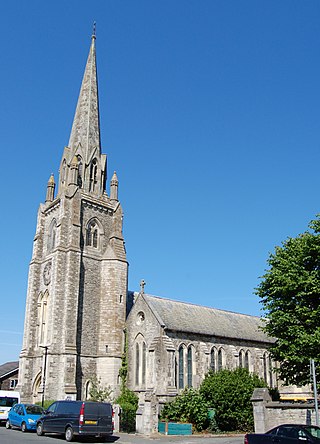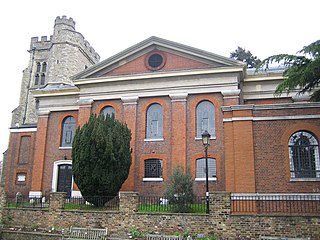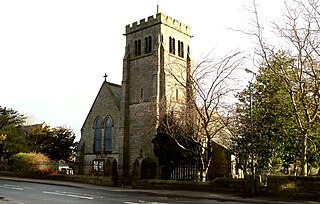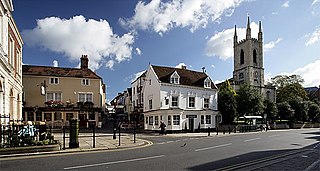
St James Church, Clerkenwell [1] is an Anglican parish church in Clerkenwell, London, England.

St James Church, Clerkenwell [1] is an Anglican parish church in Clerkenwell, London, England.
The parish of St James, Clerkenwell, has had a long and sometimes lively history. The springs which give Clerkenwell its name are mentioned during the reign of Henry II. The parish clerks of London used to perform their mystery plays, plays based on Biblical themes, in the neighbourhood, sometimes in the presence of royalty. In approximately 1100 a Norman baron named Jordan Briset founded an Augustine nunnery dedicated to St Mary, which became wealthy and influential. [2] It had a place of pilgrimage at Muswell Hill, and the parish kept an outlying tract of territory there until the nineteenth century.

At the dissolution of the nunnery under Henry VIII its church, which by then seems to have acquired a second dedication to St James, was taken into use by its parishioners who had already been using a part of it for some considerable time. The site of the nunnery was granted to Thomas Howard, 3rd Duke of Norfolk, in 1540 but the freehold of the church passed through various hands until it was conveyed in 1656 to trustees on behalf of the parishioners, who at the same time obtained the right to appoint the vicar. Unlike other parishes, they retained it after the Restoration of 1660. Elections of vicars were held, with all the excitement and paraphernalia of parliamentary elections, right down to the early years of the twentieth century, and a distinctly Low Church tradition was thereby established. This did not prevent a long struggle in the latter years of the eighteenth century with Selina, Countess of Huntingdon. This strong-minded and evangelical lady had taken over a building in the parish called Spa Fields Chapel, and insisted on appointing her own chaplains to preach there. The vicar was furious, and his action against her in the ecclesiastical courts was the cause of her secession from the Church of England.
In 1596, the playwright George Peele was buried in the church.
In 1623 the steeple fell down twice but was eventually successfully rebuilt. Pocahontas and John Rolfe's son, Thomas Rolfe, married Elizabeth Washington here in September 1632. They had a daughter named Anne a year later. Elizabeth died shortly after Anne's birth. Two years later, he returned to Jamestown, Virginia, leaving his daughter with his cousin, Anthony Rolfe.
It is believed that, in 1632, the playwright Thomas Dekker was buried in the church.
In 1641, the playwright Thomas Heywood was buried in the church.
In 1737, Matthew King, accomplice of Dick Turpin, was buried at St James, aged 25, after he was allegedly accidentally shot by Turpin during a robbery.

| Clerkenwell Church Act 1788 | |
|---|---|
| Act of Parliament | |
 | |
| Long title | An Act for pulling down the Church of Saint James at Clerkenwell in the County of Middlesex, and for building a new Church; and making a new Church Yard or Cemetery in the said Parish, with convenient Avenues and Passages thereto. |
| Citation | 28 Geo. 3. c. 10 |
| Dates | |
| Royal assent | 20 March 1788 |
By 1788 the old church, which was a medley of seventeenth and eighteenth century sections in various styles grafted onto the remains of the mediaeval nunnery church, presented an appearance of picturesque and dilapidated muddle. In that year an act of Parliament (28 Geo. 3. c. 10) was passed for the rebuilding of the church, the money to be provided by the sale of annuities. The architect was a local man, James Carr, and he produced a building which is pre-eminently a preaching-house but with carefully planned and harmonious detail clearly influenced by Wren and Gibbs. The new church was dedicated by Bishop Beilby Porteus in 1792. The upper galleries were added in 1822 for the children of the Sunday-School, founded in 1807 and still flourishing; the back parts of the upper galleries were for the use of the poor. The tower and spire were restored in 1849 by William Pettit Griffith, and Sir Arthur Blomfield restored the church and rearranged the ground floor in 1882; both works were done very well. Inside, a noteworthy feature is the curved acoustic wall at the west end. The wall at the east end originally had painted panels in the Venetian window frame; the stained glass in the east windows is by Heaton, Butler and Bayne, 1863.
The organ was built in 1792 by George Pike England to replace the one by Richard Bridge, which he took in part exchange. The new organ had three manuals, toe pedals and a Spanish mahogany case. This, together with much of England's pipe work, still survives. The rococo detail is noteworthy, especially the carved drapery over the pipes. The organ was rebuilt by Noel Mander of Mander Organs in 1978, returning to the original style after some drastic alterations made in 1928. It now has 2 manuals and pedals and 22 speaking stops.
There is a fine peal of eight bells in the tower, dating from 1791, though all the bells were recast in 1928.

A print of the church, based on a drawing by Samuel Rawle, featured as the frontispiece of The European Magazine , volume 36, published 1 August 1799.
The most noteworthy vicar of the nineteenth century was the Rev. Robert Maguire, a prolific writer of Protestant pamphlets, who had enjoyed a peculiarly stormy and exciting election. He was responsible for much work on the fabric of the church and some rearrangement of the interior.
The crypt was used for burials, but early in the twentieth century 300 coffins were moved and stored under the main West entrance. The crypt was then excavated and equipped to form a large hall. The new hall was opened by the Princess Marie Louise of Schleswig-Holstein in 1912. It was later remodelled and opened by the Rt Revd Richard Chartres, Bishop of Stepney, on 18 June 1994. The latest work created a dedicated youth space in part of the crypt and was opened by Rt Rev John Sentamu, Bishop of Stepney, on 19 December 1999.
During the 20th century, the parish of St John, which had been carved out of St James's in 1721, was reunited with it, as was the parish of St Peter. The latter had been established in 1869 for the Smithfield Martyrs Memorial Church of that name; the present church contains a memorial to the Martyrs as a commemoration of St Peter's, which suffered heavy war damage in 1941 and was finally demolished in 1955. The parish church of St John was a remnant of the priory of St John, which is now the headquarters of the Order of the Hospital of St John of Jerusalem, and the church became the chapel of the Order.
In 1998 the Rev Andrew Baughen - son of the retired Anglican bishop, Michael Baughen - became vicar, and remained at St James until 2018.
The current church retains many reminders of its past.
The Rev. Mark Jackson and the Rev. Pete Nicholas were licensed by the Bishop of Stepney to Saint James Clerkenwell in 2018. [4] The Bishop's Mission Order initiative ‘Inspire London’ that the two had initiated in 2013 was combined with Saint James Clerkenwell to form the church in its current form Inspire Saint James Clerkenwell. The Rev. Mark Jackson was licensed as incumbent in December 2022.
The Crypt underneath the Church was converted to be a usable space in 1912 and is split into a main room, a side room and a kitchen. The main room, The Crypt, has a vaulted brick ceiling and parquet flooring and is used by the church itself and the local community.
Because of its magnificent architecture and location in the heart of London the crypt is a popular venue for exhibitions, film shoots, parties, conferences and wedding receptions. It has been used as a filming location for several different productions including an episode of the BBC's Songs of Praise featuring the London Community Gospel Choir, Katie Melua's video for the song "Two Bare Feet”, the 2002 film About A Boy , the 2018 film Holmes & Watson , and Black Earth Rising .

St Dunstan's, Stepney, is an Anglican church which stands on a site that has been used for Christian worship for over a thousand years. It is located in Stepney High Street, in Stepney, London Borough of Tower Hamlets.

Holy Sepulchre London, formerly and in some official uses Saint Sepulchre-without-Newgate, is the largest Anglican parish church in the City of London. It stands on the north side of Holborn Viaduct across a crossroads from the Old Bailey, and its parish takes in Smithfield Market. During medieval times, the site lay outside ("without") the city wall, west of the Newgate.
St Mary's Church, Rotherhithe, is the local Church of England parish church in Rotherhithe, formerly in Surrey and now part of south east London. The parish is now within the diocese of Southwark and under the jurisdiction of the Bishop of Fulham. The 18th-century church is in St Marychurch Street and is dedicated to Mary, mother of Jesus, and it is particularly proud of its connections with the Pilgrim Fathers. It remains a living and working church, supported by local people and serving a broad community.

Jesmond Parish Church is a parish church in the Church of England situated in Brandling Village in the Jesmond suburb of Newcastle upon Tyne, Tyne and Wear, England. The church's official name is the Clayton Memorial Church and is unusual among Anglican parish churches in not being named after either a saint who appears in the church's calendar or a person of the Trinity. This reflects the church's conservative Evangelical roots. It is a grade II listed building.

St Helen's Bishopsgate is an Anglican church in London. It is located in Great St Helen's, off Bishopsgate.

St Leonard's, Shoreditch, is the ancient parish church of Shoreditch, often known simply as Shoreditch Church. It is located at the intersection of Shoreditch High Street with Hackney Road, within the London Borough of Hackney in East London. The current building dates from about 1740 and is Grade I listed. The church is mentioned in the line ""When I grow rich", say the bells of Shoreditch" from the nursery rhyme Oranges and Lemons.

St Luke's Church is in the village of Goostrey, Cheshire, England. It is recorded in the National Heritage List for England as a designated Grade II* listed building. It is an active Anglican parish church in the diocese of Chester, the archdeaconry of Macclesfield and the deanery of Congleton. Its benefice is combined with that of St Peter, Swettenham.

St Peter's Church is a Church of England parish church. It is located in St Albans, England, at the northern end of the town centre.

St Thomas the Martyr Church is a Church of England parish church of the Anglo-Catholic tradition, in Oxford, England, near Oxford railway station in Osney. It is located between Becket Street to the west and Hollybush Row to the east, with St Thomas Street opposite.

The Church of St Andrew, Holborn, is a Church of England church on the northwestern edge of the City of London, on Holborn within the Ward of Farringdon Without.

St Andrew's Church is an Anglican church in Church Road, Hove, in the English city of Brighton and Hove. It is usually referred to as St Andrew (Old Church) to distinguish it from another St Andrew's Church in Waterloo Street, elsewhere in Hove. It served as Hove's parish church for several centuries until 1892, although the building was in a state of near-ruin until Hove began to grow from an isolated village to a popular residential area in the early 19th century.

Holy Trinity Church is a former Church of England parish church located in the town of Ryde on the Isle of Wight. Opened in 1845, consecrated the following year and parished in 1863, it became the rapidly growing town's first parish church. A "fine, gracious" and "imposing" structure with a 134-foot (41 m) spire, it is visible for miles as a landmark at the northern end of the island, along with nearby All Saints' Church. The building has been used as a community centre since it closed for worship in 2014. Historic England has listed it at Grade II for its architectural and historical importance.

St. Mary's Church is a Grade I listed Anglican church in Chesham, Buckinghamshire, and is part of the Diocese of Oxford. Built on the site of a Bronze Age stone circle of puddingstones, parts of the church building date to the 12th century. Remodelled in the 15th and 17th centuries, the church is architecturally a mixture of English Gothic styles. Weakened by additions to the church tower and undermined by burials in and around the church, by the 19th century the building was structurally unsound. The church was remodelled and strengthened in the 1860s by George Gilbert Scott and again in the 20th century by Robert Potter.

St Mary's Church is a redundant Anglican church in St Mary's Place, Shrewsbury, Shropshire, England. It is recorded in the National Heritage List for England as a designated Grade I listed building, and is under the care of the Churches Conservation Trust, the Trust designated St Mary's as its first Conservation Church in 2015. It is the largest church in Shrewsbury. Clifton-Taylor includes the church in his list of 'best' English parish churches.

St Mary Matfelon church, popularly known as St Mary's, Whitechapel, was a Catholic then after the English Reformation a Church of England parish church on Whitechapel Road, Whitechapel, London. It is repeatedly supposed by many works and oral histories that the church was covered in a lime whitewash, which gave the chapelry (district) its common name, Whitechapel. Around 1320, it became called St Mary Matfelon. About that time it became a parish in its own right but its priest for many years was a nominee of the Rector of Stepney. The church's earliest known priest was Hugh de Fulbourne in 1329. Last rebuilt in the 19th century, the church was firebombed during the Blitz leading to its demolition in 1952. Its nave's stone footprint and graveyard – its headstones removed – are the basis of Altab Ali Park on the south side of the thoroughfare.

St Mary's Church, Twickenham, also known as St Mary the Virgin, Twickenham, is a Grade II* listed Church of England place of worship dedicated to Saint Mary the Virgin. It is on Church Street, Twickenham in the London Borough of Richmond upon Thames, England.

St Stephen's Church, Gloucester Road, is a Grade II* listed Anglican church located on the corner of Gloucester Road and Southwell Gardens in South Kensington, London, England.

The Church of St Michael and All Angels, Beckwithshaw, North Yorkshire, England, also known as Beckwithshaw Church, is an Anglican church built and furnished between 1886 and 1887 by William Swinden Barber in the Gothic Revival style as part of the Arts and Crafts movement. The stained glass windows in the same style were added in 1892. The church is listed as a Grade II historic structure; it is a pristine and unchanged example of an Arts and Crafts church retaining all its original furnishings, apart from one missing statue. However, in 2018 the church officers gained planning permission for changes which included removing all of the original pews. The first vicar of this church, from 1887 to 1894, was Charles Farrar Forster.

St John the Baptist Church is a parish church in Windsor in the English county of Berkshire. It is dedicated to St John the Baptist. The church was rebuilt in Gothic Revival style in 1822. It is the civic church of Windsor, and many Mayors of Windsor are buried in the church and churchyard. The church is Grade II* listed. Two of the three Protestant Windsor Martyrs, who were burnt at the stake in 1543, were associated with the church.
St Mary and All Saints Church is the parish church of Little Walsingham in the English county of Norfolk. It is dedicated to the Virgin Mary and All Saints. Little Walsingham was the location of the shrine of Our Lady of Walsingham, destroyed at the Dissolution. The Anglican shrine was revived by Alfred Hope Patten, the Vicar of Little Walsingham, in 1922, and the image of Our Lady of Walsingham was in the church until its translation to the new priory in 1931.